Spatio-Temporal Response of Vegetation Indices to Rainfall and Temperature in A Semiarid Region
Abstract
1. Introduction
2. Materials and Methods
2.1. Study Area (SA)
2.2. Image Classification and Accuracy Assessment
2.3. Satellite Imagery
2.4. Vegetation Indices (VIs)
2.5. Climatological Time Series
2.6. Bivariate Analysis
3. Results
3.1. Image Classification
3.2. Accuracy Assessment
3.3. Spatio-Temporal Patterns of VIs and Climatic Variables
3.4. Regression Coefficients
4. Discussion
5. Conclusions
Author Contributions
Funding
Acknowledgments
Conflicts of Interest
References
- Krogulec, E.; Zabłocki, S. Relationship between the environmental and hydrogeological elements characterizing groundwater-dependent ecosystems in central Poland. Hydrogeol. J. 2015, 23, 1587–1602. [Google Scholar] [CrossRef]
- Huang, T.; Pang, Z.; Chen, Y.; Kong, Y. Groundwater circulation relative to water quality and vegetation in an arid transitional zone linking oasis, desert and river. Chin. Sci. Bull. 2013, 58, 3088–3097. [Google Scholar] [CrossRef]
- Montandon, L.M.; Small, E.E. The impact of soil reflectance on the quantification of the green vegetation fraction from NDVI. Remote Sens. Environ. 2008, 112, 1835–1845. [Google Scholar] [CrossRef]
- Bettinger, P.; Boston, K.; Siry, J.P.; Grebner, D.L. Chapter 3 - Geographic Information and Land Classification in Support of Forest Planning. In Forest Management and Planning, 2nd ed.; Bettinger, P., Boston, K., Siry, J.P., Grebner, D.L., Eds.; Academic Press: Cambridge, MA, USA, 2017; pp. 65–85. ISBN 978-0-12-809476-1. [Google Scholar]
- Pinter-Wollman, N.; Mabry, K.E. Remote-Sensing of Behavior. In Encyclopedia of Animal Behavior; Breed, M.D., Moore, J., Eds.; Academic Press: Oxford, 2010; pp. 33–40. ISBN 978-0-08-045337-8. [Google Scholar]
- Ochege, F.U.; George, R.T.; Dike, E.C.; Okpala-Okaka, C. Geospatial assessment of vegetation status in Sagbama oilfield environment in the Niger Delta region, Nigeria. Egypt. J. Remote Sens. Space Sci. 2017, 20, 211–221. [Google Scholar] [CrossRef]
- Cui, X.; Gibbes, C.; Southworth, J.; Waylen, P.; Cui, X.; Gibbes, C.; Southworth, J.; Waylen, P. Using Remote Sensing to Quantify Vegetation Change and Ecological Resilience in a Semi-Arid System. Land 2013, 2, 108–130. [Google Scholar] [CrossRef]
- Soledad Duval, V.; María Benedetti, G.; María Campo, A. Relación clima-vegetación: adaptaciones de la comunidad del jarillal al clima semiárido, Parque Nacional Lihué Calel, provincia de La Pampa, Argentina11Trabajo realizado en el marco del proyecto Geografía Física aplicada al estudio de la interacción sociedad-naturaleza. Problemáticas a diferentes escalas témporo-espaciales, dirigido por la Dra. Alicia M. Campo, Secretaría de Ciencia y Tecnología, Universidad Nacional del Sur. Investig. Geográficas Boletín Inst. Geogr. 2015, 2015, 33–44. [Google Scholar]
- Casalini, A.I.; Bouza, P.J.; Bisigato, A.J. Geomorphology, soil and vegetation patterns in an arid ecotone. CATENA 2019, 174, 353–361. [Google Scholar] [CrossRef]
- De Keersmaecker, W.; Lhermitte, S.; Tits, L.; Honnay, O.; Somers, B.; Coppin, P. A model quantifying global vegetation resistance and resilience to short-term climate anomalies and their relationship with vegetation cover. Glob. Ecol. Biogeogr. 2015, 24, 539–548. [Google Scholar] [CrossRef]
- Zheng, Y.; Han, J.; Huang, Y.; Fassnacht, S.R.; Xie, S.; Lv, E.; Chen, M. Vegetation response to climate conditions based on NDVI simulations using stepwise cluster analysis for the Three-River Headwaters region of China. Ecol. Indic. 2018, 92, 18–29. [Google Scholar] [CrossRef]
- Krakauer, N.; Lakhankar, T.; Anadón, J.; Krakauer, N.Y.; Lakhankar, T.; Anadón, J.D. Mapping and Attributing Normalized Difference Vegetation Index Trends for Nepal. Remote Sens. 2017, 9, 986. [Google Scholar] [CrossRef]
- Liu, Y.; Li, L.; Chen, X.; Zhang, R.; Yang, J. Temporal-spatial variations and influencing factors of vegetation cover in Xinjiang from 1982 to 2013 based on GIMMS-NDVI3g. Glob. Planet. Chang. 2018, 169, 145–155. [Google Scholar] [CrossRef]
- Vermote, E.; Justice, C.; Claverie, M.; Franch, B. Preliminary analysis of the performance of the Landsat 8/OLI land surface reflectance product. Remote Sens. Environ. 2016, 185, 46–56. [Google Scholar] [CrossRef] [PubMed]
- Rahimzadeh Bajgiran, P.; Shimizu, Y.; Hosoi, F.; Omasa, K. MODIS vegetation and water indices for drought assessment in semi-arid ecosystems of Iran. J. Agric. Meteorol. 2009, 65, 349–355. [Google Scholar] [CrossRef]
- Villagra, P.E.; Meglioli, P.A.; Pugnaire, F.I.; Vidal, B.; Aranibar, J.; Jobbágy, E. Regulación de la partición del agua en zonas áridas y sus consecuencias en la productividad del ecosistema y disponibilidad de agua para los habitantes. In Red ProAgua CYTED; IDRC: Ottawa, ON, Canada, 2013. [Google Scholar]
- Montaño-Arias, N.M.; García-Sánchez, R.; la Rosa, G.O.; Monroy-Ata, A. Relación entre la vegetación arbustiva, el mezquite y el suelo de un ecosistema semiárido en México. Terra Latinoam. 2006, 24, 193–205. [Google Scholar]
- Wang, F.; Wang, X.; Zhao, Y.; Yang, Z. Temporal variations of NDVI and correlations between NDVI and hydro-climatological variables at Lake Baiyangdian, China. Int. J. Biometeorol. 2014, 58, 1531–1543. [Google Scholar] [CrossRef]
- Yang, J.; Weisberg, P.J.; Bristow, N.A. Landsat remote sensing approaches for monitoring long-term tree cover dynamics in semi-arid woodlands: Comparison of vegetation indices and spectral mixture analysis. Remote Sens. Environ. 2012, 119, 62–71. [Google Scholar] [CrossRef]
- Barbosa-Briones, E.; Cardona-Benavides, A.; Reyes-Hernández, H.; Muñoz-Robles, C. Ecohydrological function of vegetation patches in semi-arid shrublands of central Mexico. J. Arid Environ. 2019, 168, 36–45. [Google Scholar] [CrossRef]
- Fern, R.R.; Foxley, E.A.; Bruno, A.; Morrison, M.L. Suitability of NDVI and OSAVI as estimators of green biomass and coverage in a semi-arid rangeland. Ecol. Indic. 2018, 94, 16–21. [Google Scholar] [CrossRef]
- Fatiha, B.; Abdelkader, A.; Latifa, H.; Mohamed, E. Spatio Temporal Analysis of Vegetation by Vegetation Indices from Multi-dates Satellite Images: Application to a Semi Arid Area in ALGERIA. Energy Procedia 2013, 36, 667–675. [Google Scholar] [CrossRef]
- Piedallu, C.; Chéret, V.; Denux, J.P.; Perez, V.; Azcona, J.S.; Seynave, I.; Gégout, J.C. Soil and climate differently impact NDVI patterns according to the season and the stand type. Sci. Total Environ. 2019, 651, 2874–2885. [Google Scholar] [CrossRef]
- Shao, Y.; Zhang, Y.; Wu, X.; Bourque, C.P.-A.; Zhang, J.; Qin, S.; Wu, B. Relating historical vegetation cover to aridity patterns in the greater desert region of northern China: Implications to planned and existing restoration projects. Ecol. Indic. 2018, 89, 528–537. [Google Scholar] [CrossRef]
- Birtwistle, A.N.; Laituri, M.; Bledsoe, B.; Friedman, J.M. Using NDVI to measure precipitation in semi-arid landscapes. J. Arid Environ. 2016, 131, 15–24. [Google Scholar] [CrossRef]
- Abel, C.; Horion, S.; Tagesson, T.; Brandt, M.; Fensholt, R. Towards improved remote sensing based monitoring of dryland ecosystem functioning using sequential linear regression slopes (SeRGS). Remote Sens. Environ. 2019, 224, 317–332. [Google Scholar] [CrossRef]
- Mugiraneza, T.; Ban, Y.; Haas, J. Urban land cover dynamics and their impact on ecosystem services in Kigali, Rwanda using multi-temporal Landsat data. Remote Sens. Appl. Soc. Environ. 2019, 13, 234–246. [Google Scholar] [CrossRef]
- Dutta, D.; Kundu, A.; Patel, N.R.; Saha, S.K.; Siddiqui, A.R. Assessment of agricultural drought in Rajasthan (India) using remote sensing derived Vegetation Condition Index (VCI) and Standardized Precipitation Index (SPI). Egypt. J. Remote Sens. Space Sci. 2015, 18, 53–63. [Google Scholar] [CrossRef]
- Xue, J.; Su, B. Significant Remote Sensing Vegetation Indices: A Review of Developments and Applications. Available online: https://www.hindawi.com/journals/js/2017/1353691/ (accessed on 15 October 2019).
- Anuard, P.-G.; Julián, G.-T.; Hugo, J.-F.; Carlos, B.-C.; Arturo, H.-A.; Edith, O.-T.; Claudia, Á.-S. Integration of Isotopic (2H and 18O) and Geophysical Applications to Define a Groundwater Conceptual Model in Semiarid Regions. Water 2019, 11, 488. [Google Scholar] [CrossRef]
- Guillermo, M.G., Maximino; Jorge, Z.D. Potencial productivo de especies agrícolas en el distrito de desarrollo rural Zacatecas, Zacatecas. INIFAP. 2009. Available online: http://www.zacatecas.inifap.gob.mx (accessed on 24 January 2020).
- CONABIO Ecosistemas de México | Biodiversidad Mexicana. Available online: https://www.biodiversidad.gob.mx/ecosistemas/ecosismex (accessed on 24 January 2020).
- Cruz Angón, A.; López Higareda, D.; Nájera Cordero, K.C.; Melgajero, E.D.; Hernández Ramírez, D. La Biodiversidad en Zacatecas: Estudio de Estado; 2020; ISBN 978-607-8570-37-9. Available online: http://bioteca.biodiversidad.gob.mx/janium-bin/detalle.pl?Id=20200302121303 (accessed on 24 January 2020).
- Zubair, O.A.; Ji, W.; Festus, O. Urban Expansion and the Loss of Prairie and Agricultural Lands: A Satellite Remote-Sensing-Based Analysis at a Sub-Watershed Scale. Sustainability 2019, 11, 4673. [Google Scholar] [CrossRef]
- Challenger; Soberón Los ecosistemas terrestres. In Capital natural de México; Comisión Nacional para el Conocimiento y Uso de la Biodiversidad: Mexico City, Mexico, 2008; Volume I, Conocimiento actual de la biodiversidad.
- González-Trinidad, J.; Júnez-Ferreira, H.E.; Pacheco-Guerrero, A.; Olmos-Trujillo, E.; Bautista-Capetillo, C.F. Dynamics of Land Cover Changes and Delineation of Groundwater Recharge Potential Sites in the Aguanaval Aquifer, Zacatecas, Mexico. Appl. Ecol. Env. Res. 2017, 15, 387–402. [Google Scholar]
- Abdelkarim, A.; Gaber, A.F.D.; Alkadi, I.I.; Alogayell, H.M. Integrating Remote Sensing and Hydrologic Modeling to Assess the Impact of Land-Use Changes on the Increase of Flood Risk: A Case Study of the Riyadh–Dammam Train Track, Saudi Arabia. Sustainability 2019, 11, 6003. [Google Scholar] [CrossRef]
- Landsat 8 «Landsat Science. 2019. Available online: https://landsat.gsfc.nasa.gov (accessed on 24 January 2020).
- USGS EarthExplorer. Available online: http://earthexplorer.usgs.gov/ (accessed on 12 July 2016).
- Andino, R.E.C.; López, V.L.O. Cálculo de reflectancia en imágenes Landsat OLI-8, sobre la región central de Honduras, mediante software libre SEXTANTE. Cienc. Espac. 2016, 9, 81–96. [Google Scholar]
- Le, A.V.; Paull, D.J.; Griffin, A.L. Exploring the Inclusion of Small Regenerating Trees to Improve Above-Ground Forest Biomass Estimation Using Geospatial Data. Remote Sens. 2018, 10, 1446. [Google Scholar] [CrossRef]
- Rodríguez-Moreno, V.M.; Bullock, S.H. Comparación espacial y temporal de índices de la vegetación para verdor y humedad y aplicación para estimar LAI en el Desierto Sonorense. Rev. Mex. De Cienc. Agrícolas 2013, 4, 611–623. [Google Scholar]
- Fabio Rueda Calier; Luis Alfonso Peñaranda Mallungo; Wilmer Leonardo Velásquez Vargas; Sergio Antonio Díaz Báez Aplicación de una metodología de análisis de datos obtenidos por percepción remota orientados a la estimación de la productividad de caña para panela al cuantificar el NDVI (índice de vegetación de diferencia normalizada). Corpoica Cienc. Tecnol. Agropecu. 2015, 16, 25–40.
- McCarthy, M.J.; Dimmitt, B.; Muller-Karger, F.E. Rapid Coastal Forest Decline in Florida’s Big Bend. Remote Sens. 2018, 10, 1721. [Google Scholar] [CrossRef]
- Qiu, Y.; Liu, T.; Zhang, C.; Liu, B.; Pan, B.; Wu, S.; Chen, X. Mapping Spring Ephemeral Plants in Northern Xinjiang, China. Sustainability 2018, 10, 804. [Google Scholar] [CrossRef]
- Li, G.; Wang, J.; Wang, Y.; Wei, H.; Ochir, A.; Davaasuren, D.; Chonokhuu, S.; Nasanbat, E. Spatial and Temporal Variations in Grassland Production from 2006 to 2015 in Mongolia Along the China–Mongolia Railway. Sustainability 2019, 11, 2177. [Google Scholar] [CrossRef]
- Malvić, T.; Ivšinović, J.; Velić, J.; Sremac, J.; Barudžija, U. Increasing Efficiency of Field Water Re-Injection during Water-Flooding in Mature Hydrocarbon Reservoirs: A Case Study from the Sava Depression, Northern Croatia. Sustainability 2020, 12, 786. [Google Scholar] [CrossRef]
- Rosales-Rivera, M.; Díaz-González, L.; Verma, S.P. A new online computer program (bidasys) for ordinary and uncertainty weighted least-squares linear regressions: Case studies from food chemistry. Rev. Mex. Ing. Química 2018, 17, 507–522. [Google Scholar] [CrossRef]
- Verma, S.P. Geoquimiometría. Rev. Mex. De Cienc. Geológicas 2012, 29, 276–298. [Google Scholar]
- Loranty, M.M.; Davydov, S.P.; Kropp, H.; Alexander, H.D.; Mack, M.C.; Natali, S.M.; Zimov, N.S. Vegetation Indices Do Not Capture Forest Cover Variation in Upland Siberian Larch Forests. Remote Sens. 2018, 10, 1686. [Google Scholar] [CrossRef]
- Hua, L.; Wang, H.; Sui, H.; Wardlow, B.; Hayes, M.J.; Wang, J. Mapping the Spatial-Temporal Dynamics of Vegetation Response Lag to Drought in a Semi-Arid Region. Remote Sens. 2019, 11, 1873. [Google Scholar] [CrossRef]
- Witwicki, D.L.; Munson, S.M.; Thoma, D.P. Effects of climate and water balance across grasslands of varying C3 and C4 grass cover. Ecosphere 2016, 7, e01577. [Google Scholar] [CrossRef]
- Cabello, J.; Alcaraz-Segura, D.; Ferrero, R.; Castro, A.J.; Liras, E. The role of vegetation and lithology in the spatial and inter-annual response of EVI to climate in drylands of Southeastern Spain. J. Arid Environ. 2012, 79, 76–83. [Google Scholar] [CrossRef]
- Liu, H.-H. Impact of climate change on groundwater recharge in dry areas: An ecohydrology approach. J. Hydrol. 2011, 407, 175–183. [Google Scholar] [CrossRef]
- Gu, Z.; Duan, X.; Shi, Y.; Li, Y.; Pan, X. Spatiotemporal variation in vegetation coverage and its response to climatic factors in the Red River Basin, China. Ecol. Indic. 2018, 93, 54–64. [Google Scholar] [CrossRef]
- Lu, L.; Kuenzer, C.; Wang, C.; Guo, H.; Li, Q. Evaluation of Three MODIS-Derived Vegetation Index Time Series for Dryland Vegetation Dynamics Monitoring. Remote Sens. 2015, 7, 7597–7614. [Google Scholar] [CrossRef]
- Assal, T.J.; Anderson, P.J.; Sibold, J. Spatial and temporal trends of drought effects in a heterogeneous semi-arid forest ecosystem. For. Ecol. Manag. 2016, 365, 137–151. [Google Scholar] [CrossRef]
- Lin, M.-L.; Chen, C.-W.; Shih, J.; Lee, Y.-T.; Tsai, C.-H.; Hu, Y.-T.; Sun, F.; Wang, C.-Y. Using MODIS-based vegetation and moisture indices for oasis landscape monitoring in an arid environment. In Proceedings of the 2009 IEEE International Geoscience and Remote Sensing Symposium, Cape Town, South Africa, 12–17 July 2009; pp. 338–341. [Google Scholar]
- Mancino, G.; Ferrara, A.; Padula, A.; Nolè, A. Cross-Comparison between Landsat 8 (OLI) and Landsat 7 (ETM+) Derived Vegetation Indices in a Mediterranean Environment. Remote Sens. 2020, 12, 291. [Google Scholar] [CrossRef]
- Li, Z.; Li, X.; Wei, D.; Xu, X.; Wang, H. An assessment of correlation on MODIS-NDVI and EVI with natural vegetation coverage in Northern Hebei Province, China. Procedia Environ. Sci. 2010, 2, 964–969. [Google Scholar] [CrossRef]
- Chen, X.; Guo, Z.; Chen, J.; Yang, W.; Yao, Y.; Zhang, C.; Cui, X.; Cao, X. Replacing the Red Band with the Red-SWIR Band (0.74ρred+0.26ρswir) Can Reduce the Sensitivity of Vegetation Indices to Soil Background. Remote Sens. 2019, 11, 851. [Google Scholar] [CrossRef]
- Ren, H.; Feng, G. Are soil-adjusted vegetation indices better than soil-unadjusted vegetation indices for above-ground green biomass estimation in arid and semi-arid grasslands? Grass Forage Sci. 2015, 70, 611–619. [Google Scholar] [CrossRef]
- Pettorelli, N.; Vik, J.O.; Mysterud, A.; Gaillard, J.-M.; Tucker, C.J.; Stenseth, N. Chr. Using the satellite-derived NDVI to assess ecological responses to environmental change. Trends Ecol. Evol. 2005, 20, 503–510. [Google Scholar] [CrossRef] [PubMed]
- Wen, Y.; Liu, X.; Yang, J.; Lin, K.; Du, G. NDVI indicated inter-seasonal non-uniform time-lag responses of terrestrial vegetation growth to daily maximum and minimum temperature. Glob. Planet. Chang. 2019, 177, 27–38. [Google Scholar] [CrossRef]
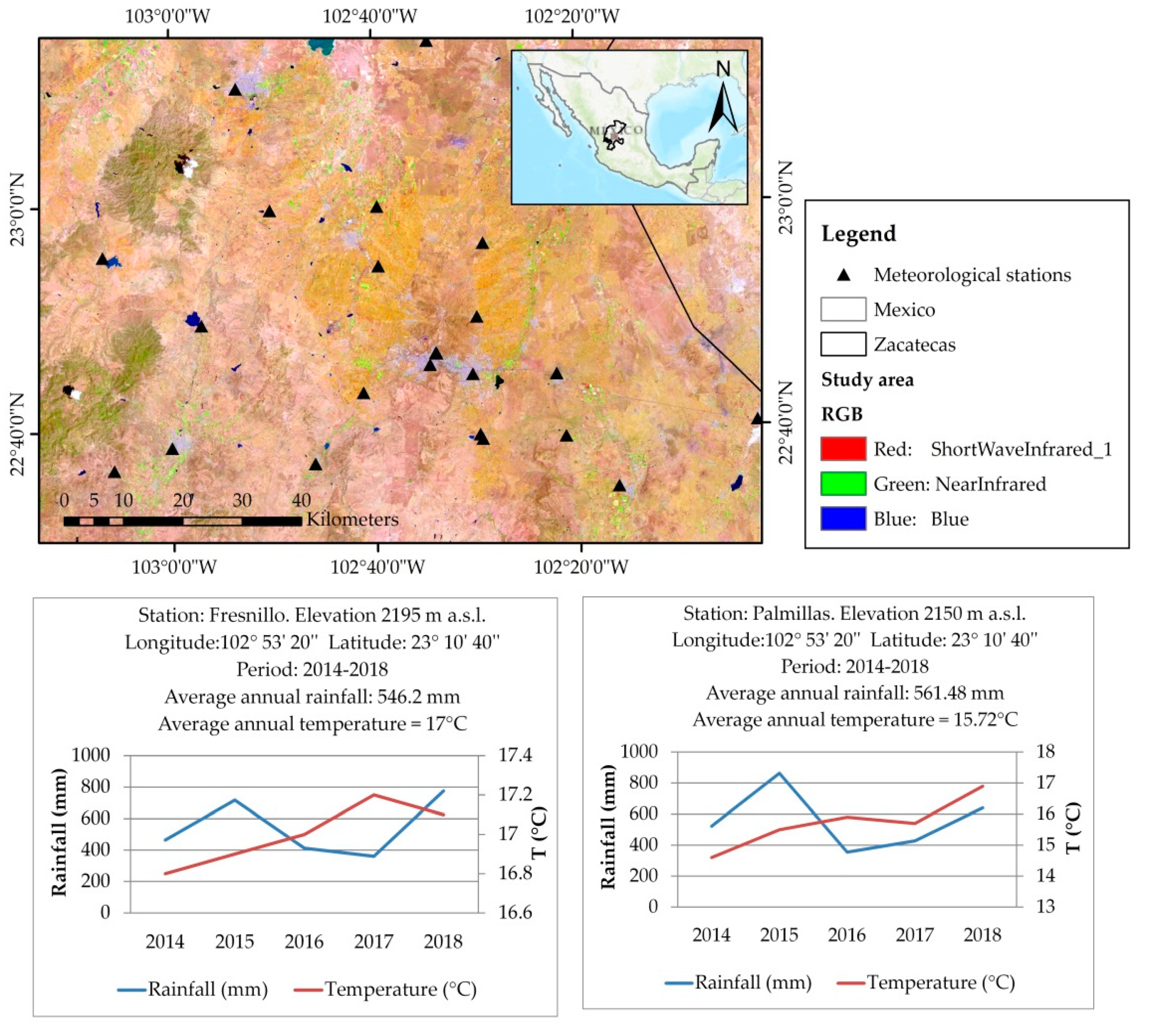
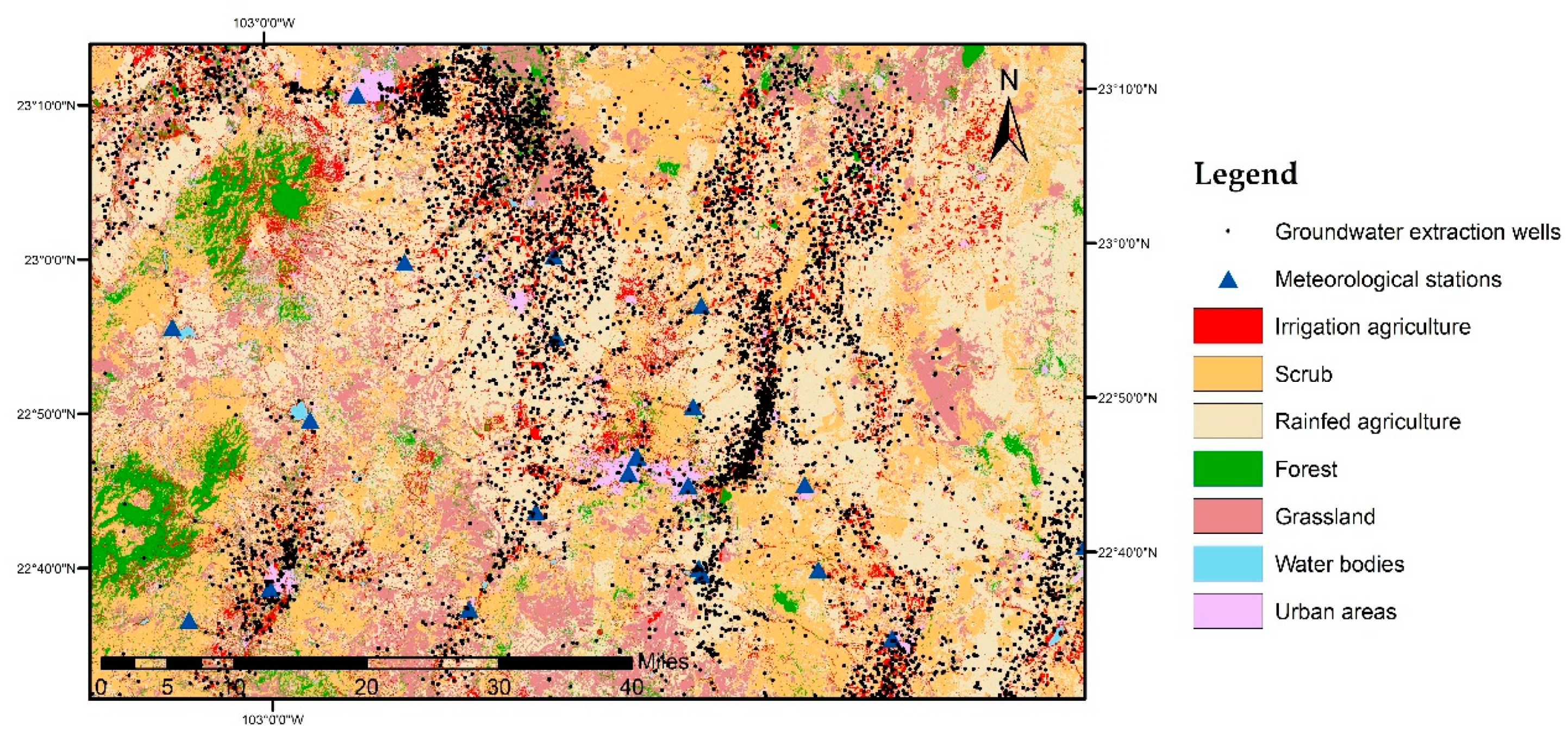
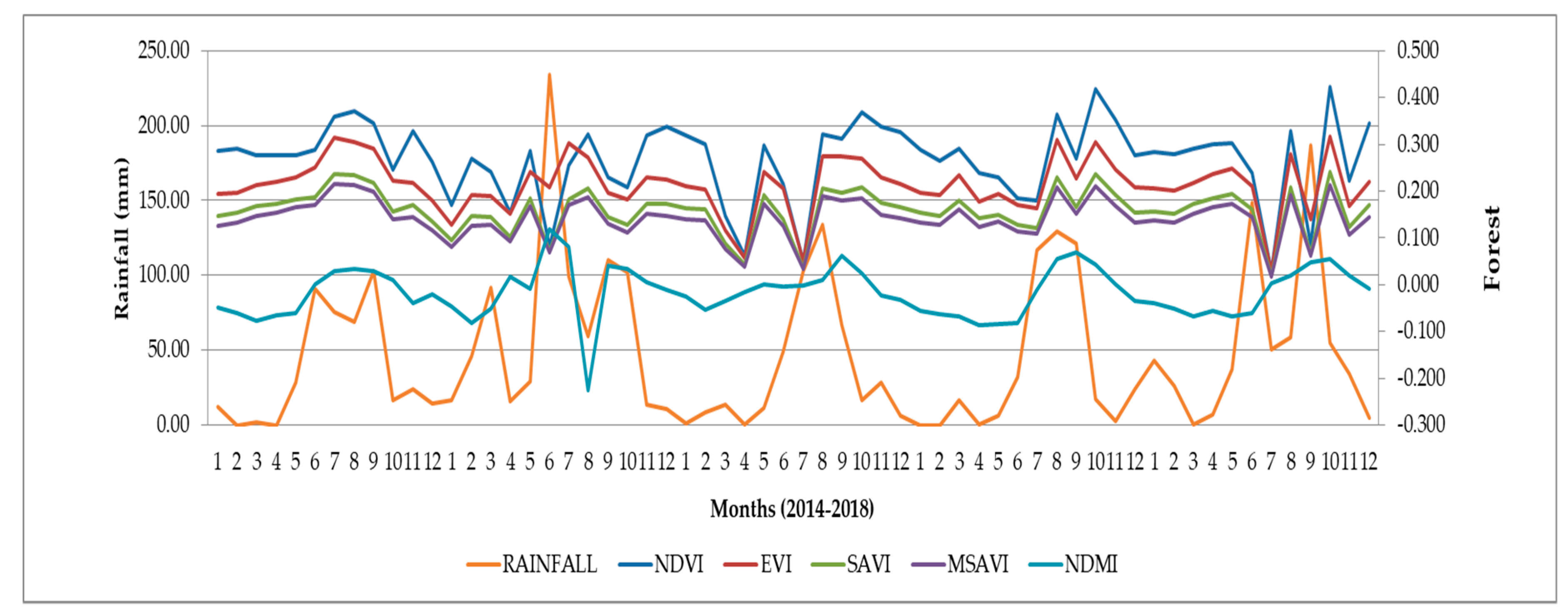
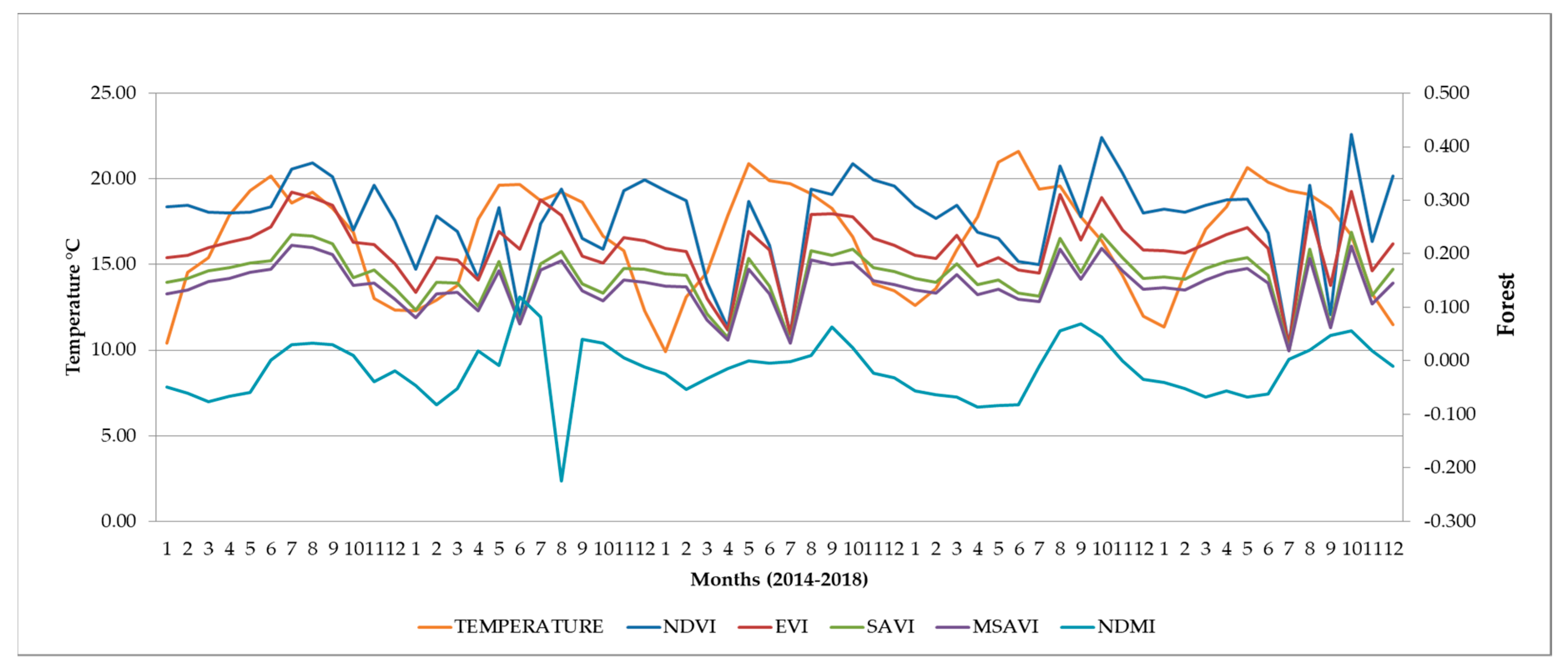
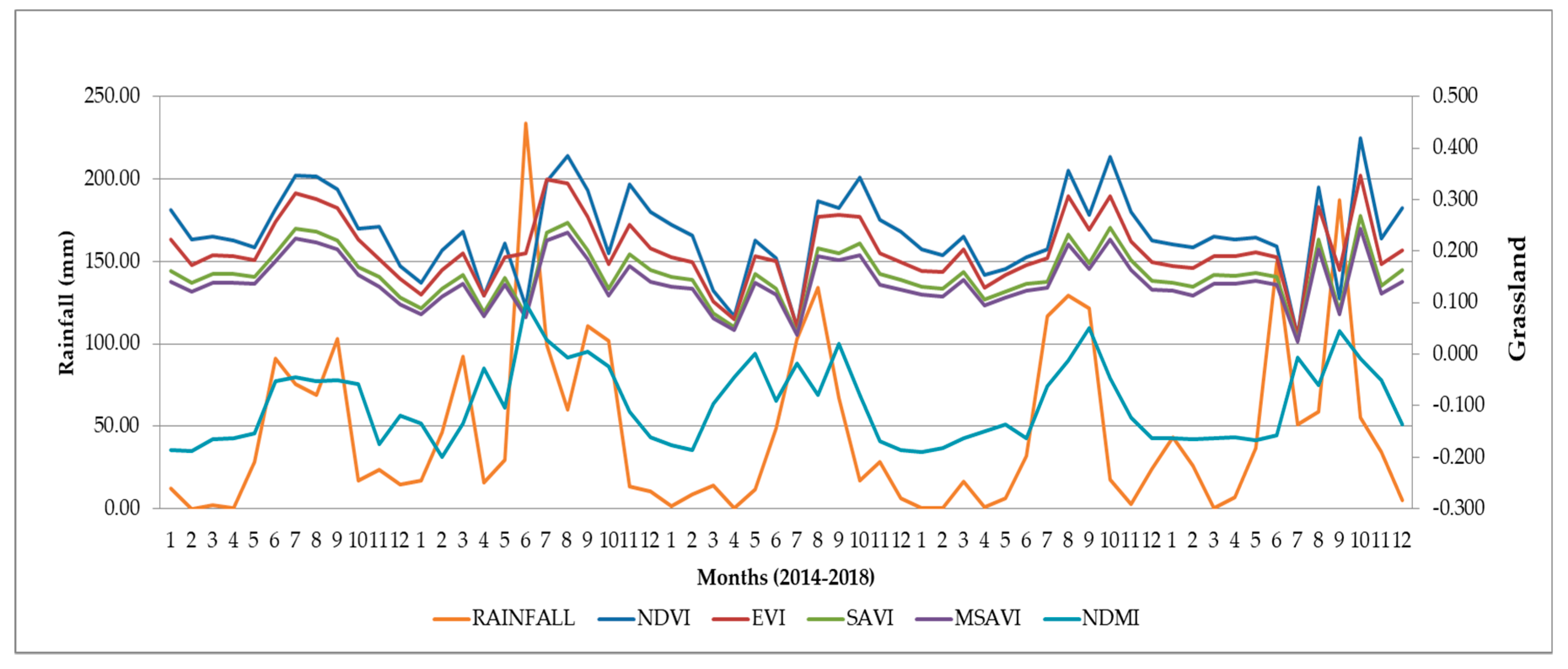
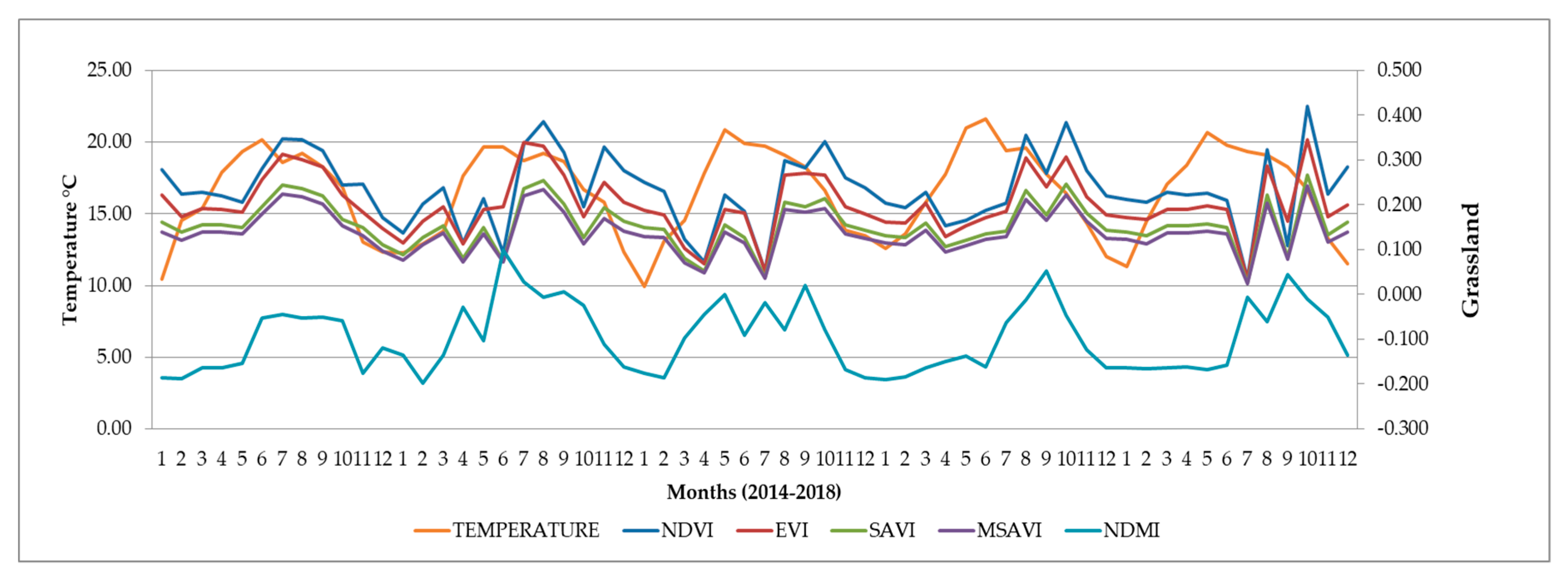


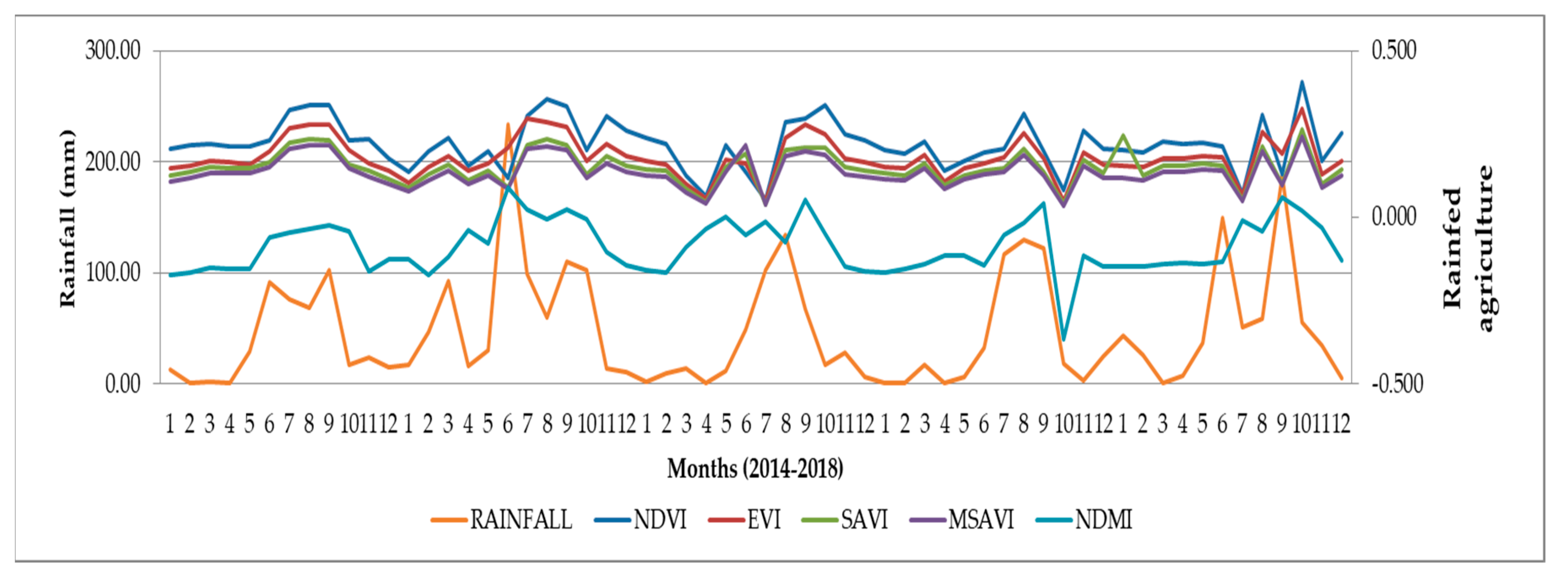
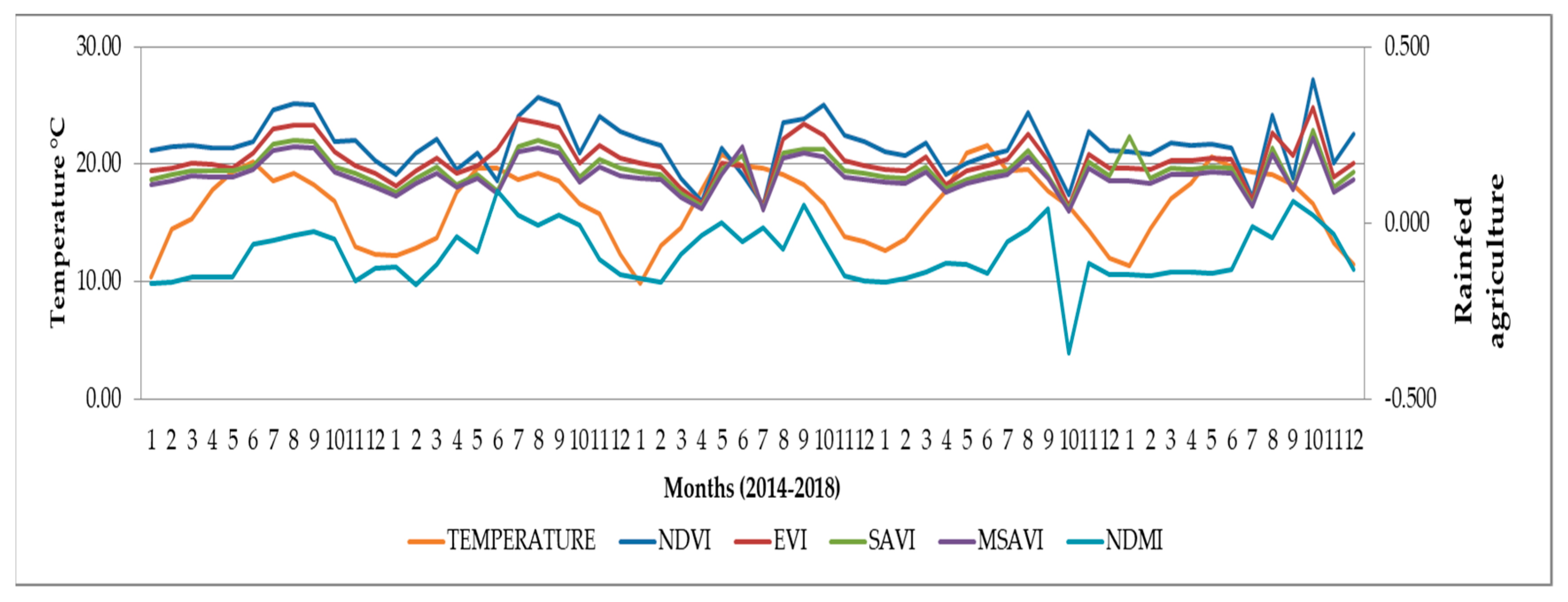


| Classification | Dominant Species | Description |
|---|---|---|
| Irrigation agriculture | Allium sativum | Garlic and onion are potential species for irrigation agriculture in the region. |
| Avena sativa | ||
| Allium cepa | ||
| Rainfed agriculture | Capsicum annum | Corn and beans are potential species for temporary agriculture in the region [31]. |
| Phaselous vulgaris | ||
| Zea mays | ||
| Forest | Pinus spp. | This ecosystem is dominated by tall trees, mainly pines and oaks accompanied by other species that develop in mountainous areas of cold to temperate climate. |
| Cupressus sp. | ||
| Juniperus sp. | ||
| Quercus sp. | ||
| Grassland | B. gracilis | They are distributed in semi-arid and cool weather areas. The average annual temperatures range between 12 and 20 °C, with average annual rainfall between 300 and 600 mm. They are found on the slopes of hills and the bottom of valleys with moderately deep, fertile soils and moderately rich in organic matter. In areas with decline and without sufficient protection they erode easily. It corresponds to communities where grasses predominate. The grasslands are medium height (20–70 cm) |
| B. scorpioides | ||
| Aristida adscensionis | ||
| Eragrotis mexicana | ||
| E. puchellum | ||
| Leptochola dubia | ||
| Lycurus phleoides | ||
| Scrub | Larrea tridentata | It is characterized by having a dry climate with little rainfall (equal to or less than 700 mm per year) in which shrubs of height less than 4 m predominate. In Zacatecas, four scrub subtypes are recognized according to the species that are more common or dominant, microphyllous, rosetophyllus, crasicaule, and spiny [32,33]. |
| Agave spp. | ||
| Yucca spp. | ||
| Opuntia spp. | ||
| Stenocereus spp. | ||
| Myrtullocactus sp. | ||
| Acacia farneciana | ||
| Prosopis laevigata | ||
| Mimosa spp. |
| Land Cover | Producer’s Accuracy (%) | User’s Accuracy (%) |
|---|---|---|
| Irrigation Agriculture | 40/40 = 100.00% | 40/48 = 83.33% |
| Scrub | 133/152 = 87.50% | 133/142 = 93.66% |
| Rainfed Agriculture | 177/185 = 95.68% | 177/193 = 91.71% |
| Forest | 26/36 = 72.22% | 26/27 = 96.30% |
| Grassland | 65/66 = 98.48% | 65/68 = 95.59% |
| Water | 20/20 = 100.00% | 20/20 = 100.00% |
| Urban Area | 20/20 = 100.00% | 20/21 = 95.24% |
| Confusion Matrix for Land Cover Map | ||||||||
|---|---|---|---|---|---|---|---|---|
| Reference Data (Number of points) | ||||||||
| Land Cover | Irrigation Agriculture | Scrub | Rainfed Agriculture | Forest | Grassland | Water | Urban Area | Ground Truth |
| Irrigation Agriculture | 40 | 1 | 3 | 4 | 0 | 0 | 0 | 48 |
| Scrub | 0 | 133 | 4 | 5 | 0 | 0 | 0 | 142 |
| Rainfed Agriculture | 0 | 15 | 177 | 0 | 1 | 0 | 0 | 193 |
| Forest | 0 | 1 | 0 | 26 | 0 | 0 | 0 | 27 |
| Grassland | 0 | 2 | 1 | 0 | 65 | 0 | 0 | 68 |
| Water | 0 | 0 | 0 | 0 | 0 | 20 | 0 | 20 |
| Urban Area | 0 | 0 | 0 | 1 | 0 | 0 | 20 | 21 |
| Total | 40 | 152 | 185 | 36 | 66 | 20 | 20 | 519 |
| Rainfall | Temperature | ||||||||
|---|---|---|---|---|---|---|---|---|---|
| Classification | Vegetation index | UWRL | UWLR (lag of one month) | UWRL | UWLR (lag of one month) | ||||
| R | R² | R | R² | R | R² | R | R² | ||
| Forest | EVI | 0.198 | 0.039 | 0.31 | 0.096 | 0.135 | 0.018 | 0.239 | 0.057 |
| MSAVI | 0.208 | 0.043 | 0.243 | 0.059 | 0.135 | 0.018 | 0.206 | 0.042 | |
| NDMI | 0.338 | 0.114 | 0.202 | 0.041 | 0.197 | 0.039 | 0.415 | 0.173 | |
| NDVI | −0.27 | 0.073 | 0.103 | 0.011 | −0.223 | 0.05 | −0.084 | 0.007 | |
| SAVI | −0.116 | 0.013 | 0.182 | 0.033 | 0.054 | 0.003 | 0.133 | 0.018 | |
| Grassland | EVI | 0.335 | 0.112 | 0.543 | 0.295 | 0.215 | 0.046 | 0.407 | 0.166 |
| MSAVI | 0.208 | 0.043 | 0.485 | 0.235 | 0.194 | 0.038 | 0.356 | 0.127 | |
| NDMI | 0.447 | 0.2 | -0.186 | 0.034 | 0.544 | 0.296 | 0.654 | 0.427 | |
| NDVI | 0.142 | 0.02 | 0.402 | 0.162 | −0.023 | 0.001 | 0.199 | 0.039 | |
| SAVI | 0.172 | 0.03 | 0.439 | 0.193 | 0.133 | 0.018 | 0.299 | 0.09 | |
| Irrigation | EVI | 0.281 | 0.079 | 0.462 | 0.213 | 0.329 | 0.109 | 0.42 | 0.177 |
| MSAVI | 0.182 | 0.033 | 0.415 | 0.172 | 0.266 | 0.071 | 0.344 | 0.118 | |
| NDMI | 0.445 | 0.198 | 0.311 | 0.096 | 0.557 | 0.31 | 0.685 | 0.469 | |
| NDVI | 0.066 | 0.004 | 0.337 | 0.114 | 0.043 | 0.002 | 0.178 | 0.032 | |
| SAVI | 0.178 | 0.032 | 0.357 | 0.127 | 0.233 | 0.054 | 0.301 | 0.091 | |
| Rainfed | EVI | 0.454 | 0.206 | 0.517 | 0.267 | 0.318 | 0.101 | 0.458 | 0.21 |
| MSAVI | 0.275 | 0.076 | 0.419 | 0.176 | 0.321 | 0.103 | 0.43 | 0.185 | |
| NDMI | 0.35 | 0.123 | −0.215 | 0.046 | 0.493 | 0.243 | 0.563 | 0.317 | |
| NDVI | 0.132 | 0.017 | 0.345 | 0.119 | 0.034 | 0.001 | 0.198 | 0.039 | |
| SAVI | 0.213 | 0.045 | 0.343 | 0.118 | 0.164 | 0.027 | 0.293 | 0.086 | |
| Scrub | EVI | 0.339 | 0.115 | 0.567 | 0.321 | 0.289 | 0.083 | 0.437 | 0.191 |
| MSAVI | 0.226 | 0.051 | 0.512 | 0.262 | 0.274 | 0.075 | 0.394 | 0.156 | |
| NDMI | 0.281 | 0.079 | −0.068 | 0.005 | 0.505 | 0.255 | 0.647 | 0.418 | |
| NDVI | 0.067 | 0.004 | 0.36 | 0.13 | −0.015 | 0 | 0.164 | 0.027 | |
| SAVI | 0.173 | 0.03 | 0.452 | 0.205 | 0.203 | 0.041 | 0.325 | 0.106 | |
© 2020 by the authors. Licensee MDPI, Basel, Switzerland. This article is an open access article distributed under the terms and conditions of the Creative Commons Attribution (CC BY) license (http://creativecommons.org/licenses/by/4.0/).
Share and Cite
Olmos-Trujillo, E.; González-Trinidad, J.; Júnez-Ferreira, H.; Pacheco-Guerrero, A.; Bautista-Capetillo, C.; Avila-Sandoval, C.; Galván-Tejada, E. Spatio-Temporal Response of Vegetation Indices to Rainfall and Temperature in A Semiarid Region. Sustainability 2020, 12, 1939. https://doi.org/10.3390/su12051939
Olmos-Trujillo E, González-Trinidad J, Júnez-Ferreira H, Pacheco-Guerrero A, Bautista-Capetillo C, Avila-Sandoval C, Galván-Tejada E. Spatio-Temporal Response of Vegetation Indices to Rainfall and Temperature in A Semiarid Region. Sustainability. 2020; 12(5):1939. https://doi.org/10.3390/su12051939
Chicago/Turabian StyleOlmos-Trujillo, Edith, Julián González-Trinidad, Hugo Júnez-Ferreira, Anuard Pacheco-Guerrero, Carlos Bautista-Capetillo, Claudia Avila-Sandoval, and Eric Galván-Tejada. 2020. "Spatio-Temporal Response of Vegetation Indices to Rainfall and Temperature in A Semiarid Region" Sustainability 12, no. 5: 1939. https://doi.org/10.3390/su12051939
APA StyleOlmos-Trujillo, E., González-Trinidad, J., Júnez-Ferreira, H., Pacheco-Guerrero, A., Bautista-Capetillo, C., Avila-Sandoval, C., & Galván-Tejada, E. (2020). Spatio-Temporal Response of Vegetation Indices to Rainfall and Temperature in A Semiarid Region. Sustainability, 12(5), 1939. https://doi.org/10.3390/su12051939







